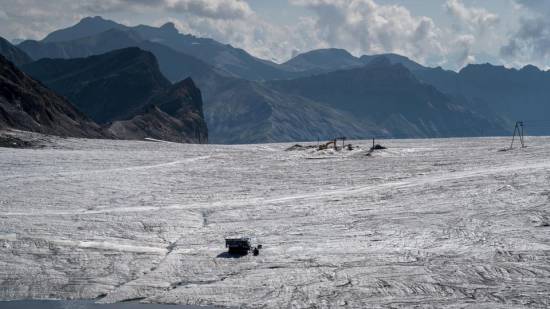The thick layer of ice that has covered a Swiss mountain pass for centuries will melt away completely within a few weeks, a ski resort has warned.
While the ice measured around 50 feet thick in 2012, the ground underneath "will have completely resurfaced by the end of September," the Glacier 3000 ski resort said in a statement on Thursday.
Following a dry winter, the summer heat waves hitting Europe have been catastrophic for the Alpine glaciers, which have been melting at an accelerated rate.
But as both, the Scex Rouge and Tsanfleuron, glaciers have retreated, the bare rock of the ridge between the two is beginning to emerge –– and will be completely ice-free before the summer is out.
"The pass will be entirely in the open air in a few weeks," the ski resort said.
The pass between both glaciers has remained iced at least since the Roman era.
The ridge is at an altitude of 9,186 feet in the Glacier 3000 ski domain and effectively marks the border between the Vaud and Wallis cantons in western Switzerland.
Covers put on sections of Tsanfleuron glacier
Skiers could glide over the top from one glacier to the other. But now a strip of rock between them has emerged, with just the last remaining bit of ice left.
"No one has set foot here for over 2,000 years; that's very moving," said Glacier 3000 chief executive Bernhard Tschannen.
The Scex Rouge glacier is likely to turn into a lake within the next 10 to 15 years.
The ski resort is working out how to adapt to the new reality if people cannot ski between the two glaciers.
"We are planning to renew the facilities in this area in the coming years, and one idea would be to shift the route of the current chairlift to allow more direct access to the Tsanfleuron glacier," said Tschannen.
Covers have been put on sections of the Tsanfleuron glacier near the pass to protect them from the heat.
Glaciologist Mauro Fischer, a researcher at Bern University, said the loss of thickness of the glaciers in the region will be on average three times higher this year compared to the last 10 summers.
In the past two weeks, two human skeletons were found on glaciers in Wallis.
Work is under way to try to identify the remains. According to the Swiss news agency ATS, the Wallis police have a list of some 300 people who have gone missing since 1925.
Source: AFP


